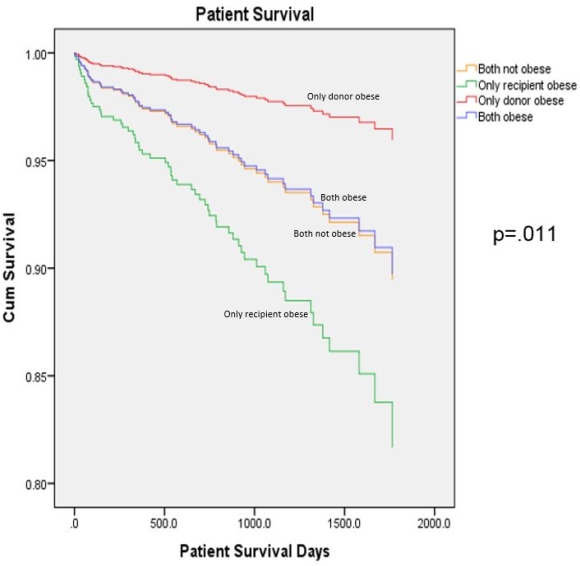Outcomes of Donor and Recipient Obesity in Kidney Transplantation
1Transplant Surgery, Tampa General Medical Group, Tampa General Hospital, Tampa, FL
2Pre-Med Undergraduate, University of South Florida, Tampa, FL
3Transplant Research, Tampa General Hospital, Tampa, FL
4Internal Medicine, Morsani College of Medicine, University of South Florida, Tampa, FL.
Meeting: 2018 American Transplant Congress
Abstract number: D127
Keywords: Kidney transplantation, Obesity, Outcome
Session Information
Session Name: Poster Session D: Kidney Donor Selection / Management Issues
Session Type: Poster Session
Date: Tuesday, June 5, 2018
Session Time: 6:00pm-7:00pm
 Presentation Time: 6:00pm-7:00pm
Presentation Time: 6:00pm-7:00pm
Location: Hall 4EF
Introduction: Obesity (BMI >30) is a world health epidemic projected to increase the incidence of diabetes, the leading cause of kidney failure. The shortage of transplant donors coupled with increased obesity makes this is an important matter to evaluate.
Hypothesis: We hypothesized no difference in outcome based on all combinations of obese and non-obese donors and recipients.
Methods: We conducted a retrospective cohort study of consecutive kidney transplants (KT) from January 2012 through December 2016 and grouped data based on four categories: 1) Obese donor and recipient (ODR), 2) Non-obese donor and recipient (NODR), 3) Obese donor and non-obese recipient (OD/NOR), and 4) Non-obese donor and obese recipient (NOD/OR). The difference in continuous variables across compared groups was assessed using ANOVA and binary variables were compared using chi-square test. Time to even data was analyzed using cox-regression. Statistical significance was set at 5% for all comparisons.
Results: Our transplant center performed 1,131 KT (608 NODR, 219 NOD/OR, 208 OD/NOR, and 96 ODR). There were no statistically significant differences between groups based on overall graft survival, and one-year readmissions and complications. Delayed graft function was significant when comparing ODR (25%) to NODR (10.4%); P<.0001 and ODR (25%) to OD/NOR (11.5%); P=0.003. Length of stay was statistically significant only when comparing NODR (8 days) to NOD/OR (7 days); P=0.043. Overall patient survival was statistically significant with the greatest patient survival for OD/NOR (98.1%) compared to ODR (94.8%), NODR (94.7%), and NOD/OR (90.9%); P=0.011.
Conclusion: Kidney transplantation using all four combinations of obese and non-obese donors and recipients is a viable option to expand the donor pool with greatest patient survival for obese donors and no difference in graft survival.
CITATION INFORMATION: Buggs J., Mehta R., Adesunkanmi M., Boone J., Rogers E., Kumar A., Bowers V. Outcomes of Donor and Recipient Obesity in Kidney Transplantation Am J Transplant. 2017;17 (suppl 3).
To cite this abstract in AMA style:
Buggs J, Mehta R, Adesunkanmi M, Boone J, Rogers E, Kumar A, Bowers V. Outcomes of Donor and Recipient Obesity in Kidney Transplantation [abstract]. https://atcmeetingabstracts.com/abstract/outcomes-of-donor-and-recipient-obesity-in-kidney-transplantation/. Accessed December 14, 2025.« Back to 2018 American Transplant Congress

